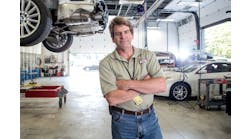For many shop owners, Erv Guyett’s business might sound like a dream: The Lincoln, Ill., shop was comfortably humming along with 15 employees generating $2.5 million in annual revenue out of a 13,500-square-foot facility. Staff turnover was virtually nonexistent and his technicians were consistently hitting efficiency benchmarks of 175 percent.
Despite that success, there was one problem looming over Collision Concepts: The business was solely reliant on Guyett for its continued success. New ideas were hard to come by from anyone besides Guyett, leaving him feeling a distinct separation between leadership at the shop and “the other side of the wall."
In an effort to get valuable feedback and new ideas to freshen up his shop from every department, Guyett decided he would begin with the internal flow of processes, namely one of the core fundamentals of any shop: communication.
Facilitating better communication, however, required coming up with a system that ensured all voices from the shop were represented and establishing a proper channel through which feedback could be provided.
The Backstory
Guyett founded Collision Concepts (then under a different name) in the late ‘90s with a business partner, Dick Taylor, whose interest Guyett eventually purchased a few years later. The shop was initially located in a neighboring town before outgrowing its facility’s space. In 2003, Guyett decided to build his own stand-alone facility in Lincoln. But coming to a smaller town meant he had to prove himself, especially since the market didn’t have a strong repair shop.
“People didn’t understand what we were trying to do,” he says. “Lincoln was really needing someone that was going to, you know, really pay attention to what the customers’ needs were and kind of cater to the customer.”
After starting with six employees and doing $1 million in revenue, Collision Concepts now has 15 employees and does $2.5 million in revenue.
The Problem
While Guyett was able to bounce ideas around with his business partner during the first years of ownership, after becoming the sole owner, Guyett was then the only one in the business bringing new ideas to the table. As the shop continued to grow, however, he realized he had 15 other staff members available whose insight he wanted to tap.
He knew he wasn’t getting the feedback that he needed from the technician standpoint, but also faced the obstacle of trying to get 15 different people together to start thinking of different processes that the shop could start implementing.
The issue wasn’t getting the entire staff to provide the feedback, but it was getting them all in one place at the same time, a task that was nearly impossible while still getting work out on time. Guyett had to ask himself: How could he maximize his staff’s input without having to get everyone together?
The Solution
Guyett first considered how he could condense feedback from 15 different people. Eventually, he settled on creating an advisory committee, where select members of each department are asked to bring agenda items to the administrative staff to help with compiling meeting topics. The advisory committee functions as follows:
Step one: Choose a representative from each department (body, refinish, detail, parts, estimator, front office). This can either be the manager or general team leader in each group and, of course, the shop manager and owner are also representatives.
Step two: Each representative is responsible for collecting feedback from his or her respective team members by either setting a deadline for when they need to report to the representatives or having individual team meetings.
Step three: The committee meetings, which take place at least once per month, involve hearing from each person and going over the major takeaways they have heard from their individual teams. The major points are considered agenda or task items.
The committee came up with four pillars—teamwork, lifetime customers, quality and profitability—to build the meetings around. The pillars also serve as a guideline to follow when pitching an idea to the advisory committee, as the idea has to fall within one of the four.
“If we were to take this idea that comes from the detail department, for instance, and implement it and it becomes part of our workflow and part of our process, who’s affected by it? Is our team affected by it? Is our customer affected by it? Is our overall quality affected? Does it have an effect on our profitability?” he says.
Step four: The general goal of the meeting is, by the end, to have some sort of an action plan to implement or solve the agendas items that were initially discussed.
Step five: Work on crossing off as many task items in a timely manner. Task items can range from everything as simple as sorting out paperwork to finding new ways to be efficient in the shops.
Holding these advisory committee meetings allows Guyett to receive the type of communication that he wasn’t typically getting before. Guyett also says that the committee has been a great way to get his more reserved staff members to participate in giving feedback and ideas.
“It’s given us an opportunity to kind of learn more about each other and how certain things—not only how certain things, but who certain things affect within our organization,” Guyett says. “Whether it be our team itself, whether it be our lifetime customer, whether it be the quality we try to exhibit or whether it be the overall profitability of our organization.”
The Aftermath
Since the first meeting in January 2017, 27 task items have been added to the agenda, 22 of which have already been implemented. Guyett says that while some tasks are small, such as a change in the flow of paperwork distribution or new ways of dealing with customer concerns, he is proud that feedback is being actively taken and executed.
After the development of the committee, the shop now has a new slogan: “Collision Concepts is the best decision for your collision.”
During the April meeting, a member from the body team recommended that the shop participate in community events. So, Collision Concepts registered for an event through The Humane Society. Guyett says they plan on making T-shirts to identify themselves at the event.
“It’s kind of neat that you get that from the technicians,” Guyett says, as he explains that he would not have received similar feedback a year ago. “We’ve got them thinking down a whole different line now.”
The Takeaway
The biggest takeaway: “I am confident that I have a team that is really working as a team,” Guyett says.
And now that the ideas are not all just his anymore, he’s finding that his team is willingly giving more consistent feedback.
“We have opened up kind of a whole new avenue of getting results without having to come up with all of the ideas and implementation of things,” he says.
And most importantly, he feels that his staff is viewing his shop as a career, “not just a place to land.”
“We’re working on some things that have core value to them and giving the employees an opportunity to be a part of those things,” he says. “It’s very easy to sit in this seat and tell everybody what they need to be doing … but it’s a heck of a lot easier when you have a team of people that are working all for the same common goal.”
Expert Advice: Making an Impact
—
Executive coach and keynote speaker, Patrick Donadio, has helped people in many industries work on bettering communication. As a specialist in leadership and communication for over 30 years, he has developed tips for helping both you, the communicator, and the receiver have a better result. Patrick Donadio’s six keys to becoming an effective communicator: IMPACT
Intention: Establish your intention for the communication. Why are you wanting to have this conversation? What do you want to achieve? The intention goes hand in hand with the message according to Donadio. Not taking an extra 30 seconds to think about your intentions typically results in a weak message.
Message: Once you know what you want to achieve, create a message that will reflect that.
Person: Think about who you are communicating with. Don’t assume that everyone is going to digest information the same way. Help the receiver by making sure you leave them enough time to take the information in.
Activate: Engage your listener. Give examples, share stories or use visuals. Visuals help you communicate better. Donadio says that something we tend to forget about are our non-verbals and gestures. Make sure your gestures, tone and non-verbals match your message.
Clarify: More often than not, there are miscommunications in communication. Just remember that the meaning of the message comes from the sender (you), not the receiver.
Transform: There are two kinds of transformation says Donadio. External transformation is when you have set goals or deadlines to achieve you message or the purpose of your communication. Internal transformation is when you or the receiver are able to not let certain beliefs get in the way of you taking action.
SHOP STATS: Collision Concepts Location: Lincoln, Ill. Operator: Erv Guyett Average Monthly Car Count: 70 Staff Size: 15 Shop Size: 13,500 sq ft; Annual Revenue: $2.5 million



